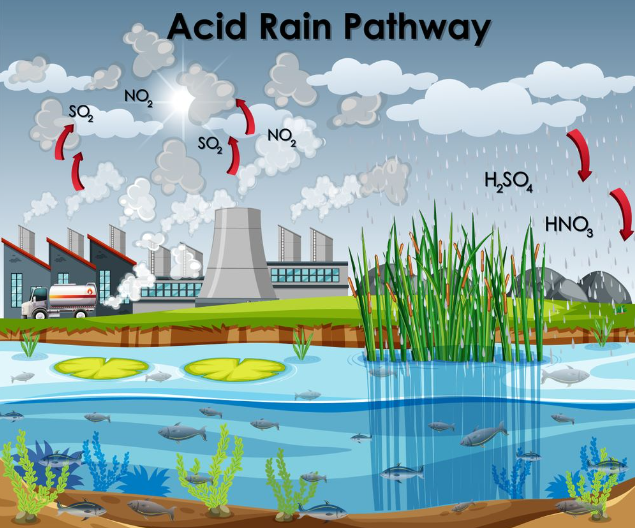Acid rain is a global environmental problem that has been the focus of much attention in recent years. The term “acid rain” refers to the deposition of acidic components in rain, snow, or other forms of precipitation. This phenomenon occurs when sulfur dioxide (SO2) and nitrogen oxides (NOx) are released into the atmosphere, where they react with water, oxygen, and other chemicals to form sulfuric and nitric acids. In this article, we will discuss the causes of acid rain, the severity of its consequences, the challenges in addressing this issue, and its effects on the environment, specifically in the United Kingdom.
Causes of Acid Rain
The primary sources of SO2 and NOx emissions are the burning of fossil fuels, such as coal, oil, and natural gas, in power plants, industrial processes, and transportation. Other sources include natural processes, such as volcanic eruptions and the decay of organic matter. However, human activities, particularly the burning of fossil fuels, are the main contributors to the acid rain problem.
Severity of Acid Rain Consequences
Acid rain has a wide range of adverse effects on the environment, human health, and infrastructure. It can lead to:
- Soil degradation: Acid rain can leach essential nutrients from the soil, making it less fertile and less able to support plant growth. This can lead to decreased crop yields and forest dieback.
- Water pollution: Acid rain can acidify lakes and rivers, killing fish and other aquatic life. It can also release toxic metals, such as aluminum and mercury, from the soil into the water, further threatening aquatic ecosystems.
- Infrastructure damage: Acid rain can corrode metals, degrade building materials, and damage infrastructure, such as bridges, roads, and monuments.
- Human health: Although acid rain does not directly harm human health, it can contribute to the formation of fine particulate matter, which can exacerbate respiratory problems, such as asthma and bronchitis.
Challenges in Addressing Acid Rain
Acid rain is a complex and persistent problem that requires a multifaceted approach to address. Reducing SO2 and NOx emissions from power plants, industrial processes, and transportation is crucial in mitigating acid rain. However, this is not an easy task, as it involves significant investment in cleaner technologies, alternative energy sources, and international cooperation. Additionally, the effects of acid rain can persist for decades, even after emissions are reduced, due to the long-lasting nature of the pollutants involved.
Acid Rain in the United Kingdom
The United Kingdom has experienced the consequences of acid rain, particularly in the 20th century when industrial emissions were at their peak. In response, the UK has implemented various measures to reduce SO2 and NOx emissions, such as the Clean Air Act and participation in international agreements like the European Union’s Large Combustion Plant Directive. As a result, acid rain emissions have significantly decreased in the UK, and the country has witnessed improvements in air quality and the recovery of some affected ecosystems. However, continued efforts are necessary to further reduce emissions and ensure the long-term health of the environment.
Acid rain is a global environmental challenge that demands concerted efforts from governments, industries, and individuals. Although progress has been made in reducing emissions, acid rain remains a persistent problem with long-lasting consequences. By understanding the causes and effects of acid rain, and by adopting cleaner technologies and alternative energy sources, we can work towards a more sustainable future and protect our environment for generations to come.
caused severe be graph below shows effect emission what



